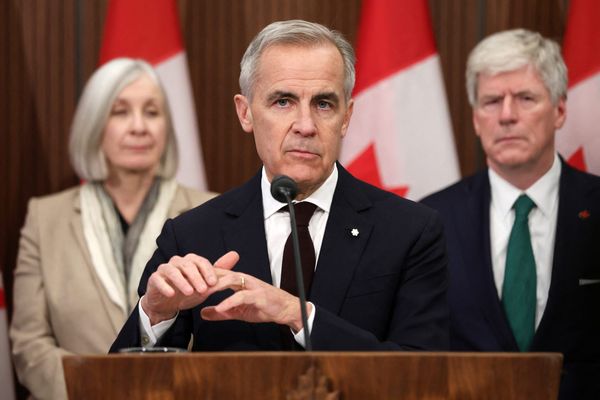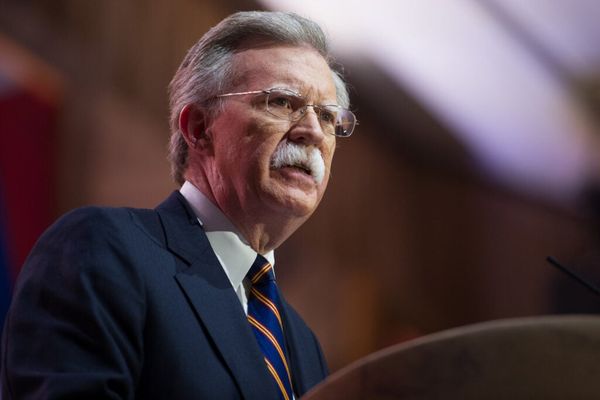
Across the road from one of Australia’s most prestigious golf courses, whose membership includes the Victorian premier, Daniel Andrews, lies a clean fill site that was destined to be transformed into parkland and sporting fields.
Situated in a green wedge zone – where locals often spot wedge-tailed eagles above – the Heatherton site had been earmarked as one of a “chain of parks” promised for Melbourne’s south-eastern suburbs, which the Andrews government committed $25m to ahead of the 2018 election.

Instead, the 40-hectare site has become one of the most contentious flashpoints on the most contentious project of the 2022 election campaign, the government’s Suburban Rail Loop (SRL).
“We shouldn’t be trading off our open spaces for a public transport project. We need them both for liveability,” says Michelle Hornstein, of the plan to turn the site into a stabling yard to house 30 trains.
Election showdown on infrastructure
Touted as Victoria’s biggest public transport project, the SRL has become the clearest policy difference between the two major parties. In August, the opposition pledged to shelve stage one of the project – SRL East – and funnel the billions in earmarked funds into the state’s burdened health sector, sparking an election showdown over infrastructure.

With two months until polling day, Guardian Australia set out to investigate how the project is being received in the suburbs that will each house one of six new underground stations as part of stage one, between Cheltenham and Box Hill.
Despite its high-profile news coverage – and the fact stage one is already under way – awareness levels are mixed.

About a third of passersby approached by the Guardian were enthused about the project, while another third had no knowledge of it despite living in communities that will bear the brunt of more than 10 years of construction. The remaining cohort was primarily indifferent to the project, while a few opposed it. This is relatively similar to statewide sentiment, where an Essential poll of 550 voters revealed 31% of respondents were indifferent while 25% opposed the project.
Waiting to catch her bus at Clayton station, the Monash University student Robin McDonald, 21, says she is excited despite the disruptions the 13-year construction phase will cause.

“I have a big issue with the way the train system all sort of centrally goes into the city and that’s the only way you can get around places,” she says.
“I prefer the sort of urban design of places like Paris where there’s a lot of lines intersecting across the city and this is kind of similar to that.”
Her enthusiasm is shared by the Deakin University student and Burwood resident Aaron Boal, 21, who is excited about one day being able to get the train directly to the airport.
“The Sky bus is not ideal,” he says.
An airport station is more than three decades away, however, with the second stage of the project projected to be completed by 2053. Early works on the stage one SRL East began in June and the first trains are expected to begin running by 2035, creating a 22-minute journey between Cheltenham – home to Southland shopping centre – and Box Hill. Certainly a key perceived advantage is its ability to connect Australia’s largest university – Monash – home to one of Melbourne’s science and medical precincts – and Deakin University’s Burwood campus to train stations on the underground line.

Even many of the community groups along the SRL East line opposed to the project say an orbital rail loop holds appeal.
“Everyone I speak to thinks the concept is good,” says Derek Screen, the president of the Pennydale Residents Action Group which includes Cheltenham – the last station due to be built along SRL East.
“But when they hear what it’s going to cost the community in parklands they begin to change their mind … we have a project that has a great idea behind it, but it falls short, really badly.”
Screen says many residents he speaks to support the benefits of the SRL such as boosting connectivity, linking train lines and getting more cars off the road.
At the heart of the community’s concerns is the loss of just under half of a local park which includes a popular skatepark – William Fry Reserve – where the underground station will be built.

While understanding some parkland loss is inevitable, Screen is frustrated that part of the park will be used for high-rise development apartments to help pay for the costs of the project.
“To take it away just to put more people in is a completely detrimental effect,” he says.
Underlying the vision of the SRL is the aim to reshape the city of Melbourne to adapt to its growing population – which is predicted to hit nine million by 2056 – by developing residential and employment precincts around each station in the outer suburbs to reduce pressure in the city centre. This means a 1.6km radius from each station will shift planning authority from local councils into the hands of the state government.
Hornstein, from the Move the Train Yard movement, describes it as “more of a planning project than a transport project” and is bemused her community will experience the noise, dust and light from the construction and operation of the stabling yard but not benefit from a train line.
“The population of Melbourne is going to grow, so we need better public transport for that. But we also need open space to support that growing population, especially sporting fields.”
On her plans at the polling booth on 26 November, Hornstein, a self-described swinging voter, offers a blunt reply: “Why would a local here vote for Labor?”
A Victorian government spokesperson said it was committed to delivering new and improved green spaces at Heatherton and in areas around the new SRL stations.
Other local criticisms of the project include the acquisition of commuter car parks and perceived poor integrations between proposed new stations and existing ones at Waverley, Box Hill and Cheltenham.
The state opposition, meanwhile, has focused its attention on cost blowouts and lack of independent scrutiny applied to the stated economic benefits. An auditor general’s report, published on Wednesday, concluded the business case of the SRL did not support “informed investment” and the financial benefits may have been overstated.

The environment effects statement of SRL East, approved by the state’s environment minister last month, estimates 312 commercial, residential and public properties will be acquired for the project. Vernita Zigouras, 83, and her husband have spent 46 years in the Box Hill home that is set to be acquired and describes it as a “terrible event”.

A longtime Labor voter, Zigouras, says since the project was announced it has “put me right off them”.
While the opposition has set up an election contest between transport and health, it’s a dichotomy that is not convincing all voters.
David Wang, 25, who works in Glen Waverley, says he is leaning towards voting for Labor but is adamant each side must convince voters it can deliver on both.
“We need the investments in health as well as this project,” he says.
But Hornstein supports the opposition’s plans to shelve the project, despite the Andrews government warning it would result in further cost blowouts.
“It’s a massive city-changing project and needs to be done in the right way.”







